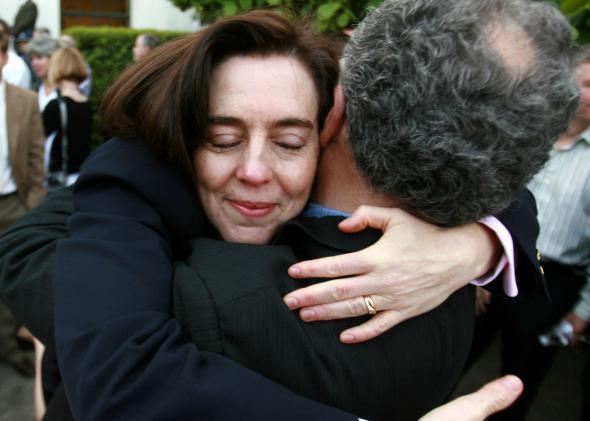This article originally appeared in The Conversation.
“It would have been so much easier for us if you were a lesbian” Kate Brown’s parents declared when she came out as bisexual.
Brown, Oregon’s new governor and the nation’s first openly bisexual governor, recalled feeling like she had “a foot in both worlds” upon realizing she was bisexual.
At the time of her public (and involuntary) “outing” by the Oregonian during one of her many close campaigns for public office, bisexuals were (and still are) perceived as “greedy, promiscuous or indecisive” and shunned by both heterosexuals and gays alike. Brown herself was told by gay friends that she was only “half queer.”
Brown, however, immediately embraced her public identity and is now widely viewed by LGBTQ Oregonians as one of their fiercest public allies.
And although Brown’s colleagues and friends tend to diminish the relevance of her bisexuality, viewing her substantive policy work as a far more important political legacy, pundits disagree.
For them her bisexuality—and her position as the first openly LGBTQ governor to serve office—quickly became national news.
So how do we understand the importance of Brown becoming the first openly LGBTQ governor? And what does her story say about Oregon?
In many ways Oregon’s gay rights record is puzzling.
On the one hand Portland, the state’s largest city, is regarded as one of the most LGBTQ-friendly cities in the country. At the same time, though, the state has rehearsed some of the most virulent anti-gay rights campaigns in the country.
Indeed, in the 1980s and ‘90s, Oregon was a testing ground for a growing anti-gay movement. This was in part because conservative groups could have direct access to voters through the state’s heavily used ballot initiative process and in part because of deep ideological differences between the state’s rural and urban residents. Conservative activists hoping to ignite anti-gay fervor viewed Oregon as a perfect location to experiment with a range of anti-gay initiatives.
The first effort, inspired by Anita Bryant’s infamous and vitriolic campaign to “save our children” from gay and lesbian “recruitment,” involved taking on the state’s governor—an ally to LGBTQ Oregonians.
Then Gov. Neil Goldschmidt had issued an executive order in 1987 protecting public employees from discrimination on the basis of sexual orientation. The Oregon Citizen’s Alliance, a group hoping to make a name for itself as a conservative political powerhouse, swiftly put this executive order to voters in a ballot initiative. And the voters overturned it by a 5 percent margin.
Riding on its electoral high the OCA then set its sights on loftier goals. In 1992, they asked the voters to amend the state constitution to place homosexuality on equal footing with pedophilia as “unnatural and perverse.”
The effort failed, but the OCA continued to focus its efforts (and voter attention) on lesbians and gays throughout the 1990s.
In 1994, Measure 13 asked voters to constitutionally proscribe the state from “creating classifications” based on sexual orientation.
In 2000, Measure 9 offered voters the chance to abolish any mention of homosexuality in public schools.
Both measures failed at the ballot box but the OCA succeeded in diverting critical LGBTQ advocacy resources away from furthering gay rights initiatives. And OCA’s grassroots campaigning across the state resulted in over two dozen cities and counties voting to bar LGBTQ Oregonians from seeking non-discrimination protections.
The rollercoaster ride of gay rights initiatives that characterizes Oregon politics in the last three decades is largely due to a public and contentious battle between conservative voters and progressive elected officials (representing largely urban interests).
It was a pro-gay rights governor who kickstarted the OCA’s anti-gay efforts. In 1992, a state appellate court overturned Measure 8, and one year later state legislators made it illegal to “single out citizens or groups of citizens on account of sexual orientation,” rendering moot the city and county-based anti-gay ordinances.
In 2004, Oregonians voted to ban same-sex marriage in the state. Soon after state legislators passed sweeping domestic partner legislation (sponsored by Brown), giving LGBTQ Oregonians the same statewide rights and benefits as heterosexual married couples.
When members of the LGBTQ community went to court to overturn the state’s marriage ban in 2014, state officials declined to defend the law in court—hastening its removal.
As these battles between deeply homophobic organizations and fiercely progressive gay rights efforts were taking place, Oregon emerged as a pioneer state for LGBTQ elected officials.
The state is home to the nation’s first openly gay mayor of a top-30 city (Sam Adams, Portland); the first openly transgender mayor (Stu Rasmussen, Silverton); and the first openly LGBTQ Speaker (Tina Kotek).
In fact, her historic ascendancy as the first openly LGBTQ governor to serve is not Kate Brown’s first “first.” In 2008, she became the first openly LGBTQ person to win a statewide election for secretary of state.
Against this backdrop, then, Brown’s promotion to governor seems to be par for the course in Oregon’s colorful history on gay rights.
That leaves us to ponder the implications of this historic occasion.
How will Brown fare at the polls come 2016, when she sits for special election? Will LGBTQ Oregonians secure additional policy protections as a result of the Brown-Kotek legislative powerhouse? To what degree will this partnership position Oregon as a national leader in gay rights? This has yet to be played out.
In the meantime, tensions are still percolating within the state’s more conservative communities. It was, remember, Oregon that made national headlines when a bakery refused to make a cake for a gay couple’s wedding.
What is clear, however, is that Brown’s appointment, in concert with both her open and proud identification as bisexual and the many recent political gains for LGBTQ individuals nationwide, solidifies a new era of possibilities for those who identify and support LGBTQ efforts.
That Brown’s sexuality is even described as historic, rather than abhorrent (as it likely would have been a handful of decades ago), speaks volumes about the shift American public opinion has made.
